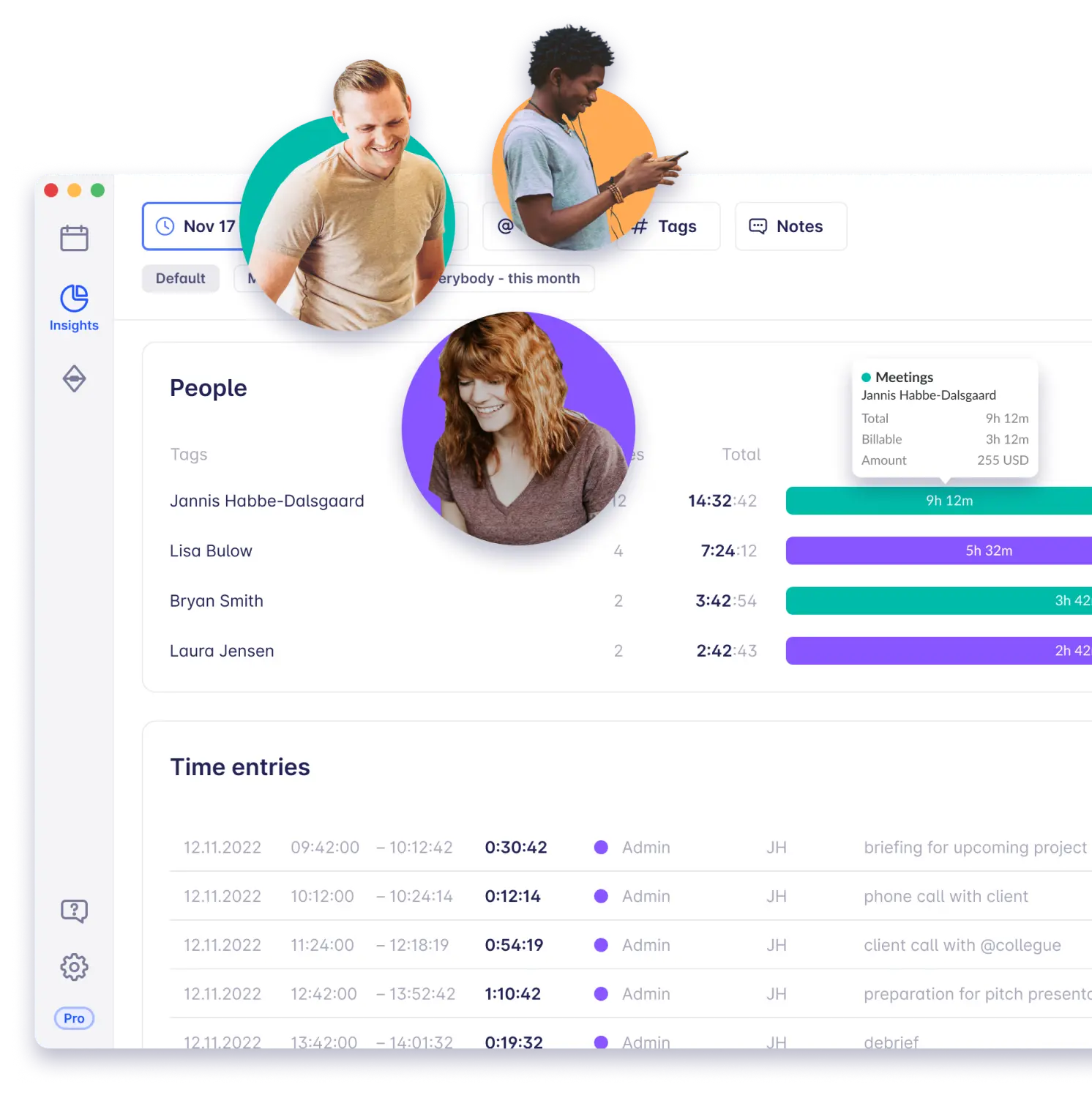How to Increase Billable Hours and Revenue: Best Practices
In today’s competitive professional landscape, maximizing billable hours is a top priority for individuals and businesses across various industries.
Whether working for a consulting business, marketing agency, or law firm, increasing billable hours directly correlates with enhanced productivity and improved financial outcomes.

An industry report on digital agencies states that the average employee is expected to bill 25 hours per week and work another 13 hours on non-billable tasks for a total expected weekly commitment of 38 hours.
According to the Yale Law School Career Development Office, law firms’ average yearly billable hours usually range between 1700 and 2300.
As the bar is raised, knowing how to increase your billable hours without sacrificing your work-life balance is essential.
Time tracking tools have emerged as valuable allies in this endeavor, enabling individuals and teams to measure their time accurately.
Professionals can unlock their full potential and achieve tremendous success by effectively managing time, optimizing workflows, and leveraging the right strategies.
This article explores actionable tips and proven strategies to increase billable hours.
From setting clear goals and streamlining processes to leveraging time-tracking tools and optimizing time management, we’ll delve into critical approaches that can empower you to maximize your working hours.
How to increase billable hours with 9 easy tips
1. Erfasse deine Zeit
Keeping track of how many hours of billable time you spend is a simple yet very effective strategy to bill accurately. When professionals do not track their time, often billable hours estimates are guessed, and the risk is to bill unrealistically. We’ll dive deeper into time tracking for billable hours in a dedicated section of this article.

Learn how to maximize billable hours, and keep track of budget with Timeular!
Valuable resource:
- Die beste Zeiterfassungssoftware für Mitarbeiter
- Wie behalten Anwälte den Überblick über abrechenbare Stunden?
2. Be clear on what’s billable and what’s not
Distinguishing between billable and non-billable time can be a complex matter. Don’t you think? So, have a look at the following examples:
- Should the time spent driving to a client meeting be considered billable?
- What about a brief phone call?
- What action should be taken if a client cancels a meeting? Should they still be charged for the time that could have been allocated to another task?
Unfortunately, there’s no definitive answer applicable to all situations.
The decision of what to charge and what to charge for ultimately rests in your hands.
Your choices should be guided by principles of ethics and authenticity, considering what your clients are likely to accept and the prevailing practices within your industry.
Schau dir das an:
- Kostenlose Vorlagen für Stundenzettel
- Kostenlose Zeitplan-Vorlagen
- Kostenlose Vorlagen für abrechenbare Stunden

However, whether or not you intend to bill for canceled meetings and administrative work.
It’s imperative to communicate this policy clearly to your clients from the outset and include it in your contractual agreements.
Clients always appreciate transparency and consistency, and there’s nothing worse than unforeseen costs to cloud a once-good relationship.
On the other hand, you and your team must know exactly what is billable and what’s not.
With that knowledge, you can focus most of your time on the tasks that will bring in money for the company.
3. Set clear goals and prioritize tasks
Setting clear goals and prioritizing tasks is essential for maximizing billable hours.
Clearly define the objectives for each project or client and identify the most critical tasks that contribute directly to revenue generation.
You know exactly what needs to be accomplished when you have clear goals. This clarity helps you stay focused and avoids wasting time on non-essential tasks.
You can maximize your productivity by channeling your efforts towards activities directly contributing to billable work.
Additionally, prioritizing tasks ensures that your team first tackles the most important and time-sensitive work.
By identifying high-value tasks and addressing them promptly, you can make better use of your time and increase the overall business efficiency and, of course, workflow efficiency.
This allows you to complete more billable work within a given timeframe.
4. Minimize non-billable activities
Minimizing non-billable work is crucial for all kinds of businesses as it directly impacts their profitability and overall success.
Non-billable activities, although necessary to some extent, can drain valuable resources, including time, manpower, and finances.
By reducing non-billable work, companies can optimize their operational efficiency and increase the time spent on revenue-generating tasks.
This leads to higher billable hours, improved productivity, and better financial results.

With Timeular, you can access accurate reports with just one click
To minimize non-billable activities and maximize the time your team spends on billable work, consider following some of these strategies:
- Effective time tracking: Leverage reliable time tracking software to accurately record the time spent on various activities. This will give your team insights into how your time is allocated and help identify areas where non-billable activities consume excessive resources. Effective time tracking also enables you to demonstrate the value of your billable work to clients. We’ll develop this subject further below.
- Delegation is key: Delegate non-billable tasks that others can handle, whether within your team or by outsourcing to external resources. This allows you to focus on higher-value billable work while ensuring that essential non-billable tasks are still addressed.
- Automate routine tasks: Identify repetitive and time-consuming non-billable activities that can be automated. Utilize technology tools, such as project management software, automation software, or scheduling tools, to streamline administrative tasks and reduce manual effort.
By implementing these strategies, you can increase the proportion of billable work and improve your overall productivity.
Lies auch: Wie führt man Automatisierung am Arbeitsplatz ein?
5. Improve workflow efficiency
Improving workflow efficiency is crucial for increasing billable hours and optimizing productivity.
Companies can maximize the time spent on billable work by streamlining processes, eliminating bottlenecks, and improving task allocation.
This can involve identifying and automating repetitive tasks, implementing effective project management tools, and establishing clear communication channels.
Efficient workflow management ensures that:
- resources are utilized effectively
- deadlines are met
- non-value-added activities are minimized
By continuously evaluating and refining workflow processes, companies can enhance their ability to deliver high-quality work, meet client expectations, and ultimately increase billable hours, leading to improved financial performance.

6. Optimize time management
We need to talk about time management optimization. While some people can plan and be productive, it’s not the case for everyone.
That’s why dozens of new time management techniques have emerged in recent years.
Time management techniques are methods or rules people follow to be more productive and efficient.
In this article, we won’t cover all those techniques, but you can find out what are the best time management techniques in our guide, which includes also how to do Time Blocking.
A big fan of this technique is the CEO of Tesla. Yes, Elon’s Musk 5-minute rule is based on time blocking.
So, you need to start by identifying the tasks or activities you need to accomplish and determine their priority.
Then, estimate the time required for each task. Ensure that you allocate a realistic amount of time for each task.
Consider the complexity and effort required, and give yourself some buffer time for unforeseen circumstances or additional work.
After determining how much time you’ll need for each task, it’s time to define time blocks.
Allocate specific blocks of time in your schedule for each activity.
- You might be interested in:
How to teach time management
Free time blocking templates
Beispiel:
You might designate a block from 9:00 AM to 10:30 AM for focused work on a project, another block from 11:00 AM to 12:00 PM for meetings, and so on.
Once you’ve assigned time blocks, treat them as appointments or commitments.
Protect these blocks from interruptions or distractions, and avoid scheduling conflicting activities during those times.
7. Minimize distractions and avoid procrastination
Distractions can significantly impact billable hours. Identify common distractions in your work environment and take steps to eliminate them.
This may involve turning off notifications on your phone or computer, creating a dedicated workspace, or establishing boundaries with colleagues.
Creating a focused and distraction-free environment can increase your productivity and maximize billable hours.
Also, take a moment to assess your time on low-value tasks and any tendencies towards procrastination.
Procrastination is a widely recognized behavior among individuals — let’s face it, we all do it —with some people even spending up to 2 hours procrastinating on a single task.
Recognizing and addressing these tendencies can significantly improve overall productivity and efficiency.

8. Leverage technology and tools
Technology can be a friend or foe when it comes to increasing productivity.
If, on the one hand, our devices, apps, and software can tend to distract us from our work, they can also be great allies in managing our time, allocating resources, and automating tasks, among other things.
Utilize a time tracking tool and project management software to measure and manage your time accurately.
These tools provide valuable insights into time allocation, project progress, and resource allocation and utilization.
They can also enable you to identify bottlenecks, allocate resources efficiently, and make data-driven decisions that enhance billable hours.
9. Collaborate effectively
Last but not least, efficient collaboration with clients, colleagues, and stakeholders is vital to maximizing billable hours.
Establish clear communication channels, set expectations, and proactively manage client interactions.
By fostering strong relationships and effective collaboration, you can minimize misunderstandings, avoid rework, and optimize billable hours.
10. Effective schedules
Strategically scheduling employees can significantly contribute to an increase in billable hours for a business.
A well-designed employee schedule takes into account employee availability, skills, and task dependencies, ensuring that the right individuals are allocated to projects that align with their expertise.
This targeted assignment of tasks optimizes productivity, enabling employees to complete assignments efficiently and effectively, thus maximizing billable hours.
Moreover, an intelligently structured schedule allows for the effective allocation of workloads, preventing bottlenecks and ensuring a consistent workflow.
By spreading tasks evenly across employees and factoring in buffer time for unexpected delays, businesses can maintain steady progress and minimize disruptions that could hinder billable hours.
In essence, a well-managed employee schedule becomes a powerful tool that not only enhances overall time management but also plays a pivotal role in increasing billable hours through optimized resource allocation and streamlined workflow coordination.
How time tracking helps increase billable hours
Time tracking is the process of recording the working hours.
It is crucial to increase billable hours by providing valuable insights and enhancing productivity.
Here’s an in-depth explanation of how time tracking helps in achieving this goal:
Accurate time allocation
Time tracking allows teams to accurately allocate their time to specific tasks, projects, or clients.
By recording the time spent on each activity, individuals clearly understand where their time is being utilized.
This knowledge enables them to identify areas where non-billable activities or inefficiencies may take up excessive time, helping them streamline their workflow and prioritize billable tasks.
Enhanced productivity
Time tracking promotes self-awareness and accountability.
When professionals know their time is being recorded, they tend to become more focused and disciplined in managing their work.
This heightened sense of responsibility encourages better time management practices, reducing distractions and unproductive activities. As a result, billable hours increase as more time is dedicated to revenue-generating tasks.
Improved time estimation
Time tracking gives your team valuable data on how long specific tasks or projects take.
You can make more accurate estimations for future projects by checking historical time records.
This ensures you and your team can allocate sufficient time for each task, avoiding underestimations that may result in non-billable overtime or overestimations that could lead to idle time.
Improved time estimation helps optimize resource allocation, allowing professionals to maximize their billable hours.

Transparent billing
Time tracking serves as concrete evidence for invoicing clients accurately.
Detailed time records validate the services rendered, enabling professionals to generate comprehensive invoices that outline the tasks performed, their durations, and the associated billing rates.
This transparency instills confidence in clients and reduces the likelihood of billing disputes.
Accurate invoicing ensures that all billable hours are accounted for, improving revenue generation.
Insights for performance analysis
Time tracking data provides valuable insights for performance analysis and process improvement.
By examining the time spent on different tasks or projects, you can
- identify areas where efficiency can be enhanced
- spot bottlenecks
- eliminate time-wasting activities
- optimize workflows to increase billable hours
Regular analysis of time tracking data enables professionals to refine their working practices and identify growth opportunities continuously.
Zusammenfassung
In summary, time tracking is a powerful tool for increasing billable hours.
It enables teams to accurately allocate their time, enhance productivity, improve time estimation, provide evidence for invoicing, and gain insights for performance analysis.
By leveraging time tracking effectively, you can optimize your workflows, maximize billable hours, and achieve higher levels of efficiency and profitability.
Schlussfolgerung
Maximizing billable hours is essential for professionals and businesses across many industries aiming to enhance their profitability and productivity.
By harnessing the power of time-tracking tools, you can gain valuable insights into your time allocation, boost accountability, streamline workflows, and make informed decisions regarding time management.
With a proactive approach to optimizing billable hours, you and your team will be able to achieve greater success in your endeavors and build a reputation for efficiency and reliability in your industry.
FAQ
When seeking a rise in billable hours, present a compelling case by highlighting your productivity, value to the organization, and service demand.
Demonstrate your achievements and capacity for more work, and emphasize how the increased hours will positively impact the business.
Billing consulting hours usually involve tracking the time spent on each client or project with a time-tracking tool and charging accordingly.
Create detailed invoices that outline the services provided, the duration of each task, and the applicable billing rate to build trust with clients.
To achieve a yearly target of 2000 billable hours, aim for an average of 40 hours per week across a standard 50-week work year.
Yet, it’s crucial to account for vacation time, holidays, and non-billable activities that impact weekly billable hours.
While 40 billable hours per week is considered normal in some professions like lawyers or consultants, it may be seen as a relatively high workload in others.
Considering that the average worker works 40 hours a week, aiming for 40 billable hours leaves no time for meetings, administrative work, and training, forcing you to work more.
In professional services like consulting or legal work, the target is often 60-80% billable time, but other industries may have lower percentages due to non-billable activities.
No. Non-billable hours typically refer to time spent on admin tasks, training, meetings, or internal projects that are not directly billed to clients.
While clients won’t pay directly for these hours, they are often considered part of your job responsibilities and will help grow your business over time.
Paid time off (PTO) does not count toward billable hours since it refers to the time taken for personal leave, vacation, or illness.
Billable hours only include time spent on client-related work or tasks that directly generate revenue.
Pricing billable hours depends on various factors, including your expertise, the market demand for your services, and industry standards. Common pricing methods include hourly rates, fixed project fees, or value-based pricing. Use the markup calculator to calculate markup, and the margin calculator to calculate margin.
Lies mehr: